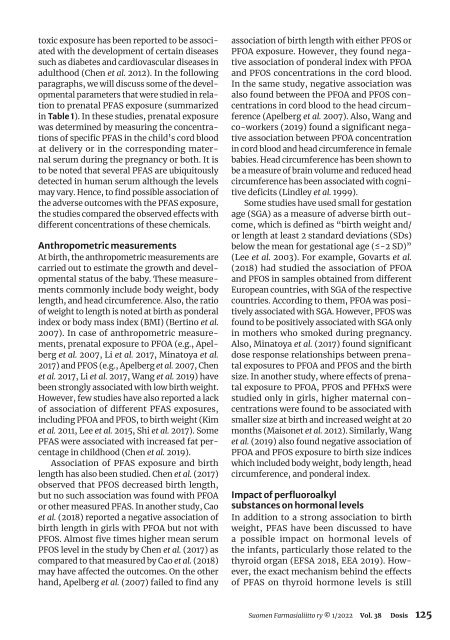DOSIS 1/2022
Farmaseuttinen aikakauskirja DOSIS 4/2021 vol.37 5uomen Farmasialiitto ry
Farmaseuttinen aikakauskirja DOSIS 4/2021 vol.37 5uomen Farmasialiitto ry
Create successful ePaper yourself
Turn your PDF publications into a flip-book with our unique Google optimized e-Paper software.
toxic exposure has been reported to be associated<br />
with the development of certain diseases<br />
such as diabetes and cardiovascular diseases in<br />
adulthood (Chen et al. 2012). In the following<br />
paragraphs, we will discuss some of the developmental<br />
parameters that were studied in relation<br />
to prenatal PFAS exposure (summarized<br />
in Table 1). In these studies, prenatal exposure<br />
was determined by measuring the concentrations<br />
of specific PFAS in the child’s cord blood<br />
at delivery or in the corresponding maternal<br />
serum during the pregnancy or both. It is<br />
to be noted that several PFAS are ubiquitously<br />
detected in human serum although the levels<br />
may vary. Hence, to find possible association of<br />
the adverse outcomes with the PFAS exposure,<br />
the studies compared the observed effects with<br />
different concentrations of these chemicals.<br />
Anthropometric measurements<br />
At birth, the anthropometric measurements are<br />
carried out to estimate the growth and developmental<br />
status of the baby. These measurements<br />
commonly include body weight, body<br />
length, and head circumference. Also, the ratio<br />
of weight to length is noted at birth as ponderal<br />
index or body mass index (BMI) (Bertino et al.<br />
2007). In case of anthropometric measurements,<br />
prenatal exposure to PFOA (e.g., Apelberg<br />
et al. 2007, Li et al. 2017, Minatoya et al.<br />
2017) and PFOS (e.g., Apelberg et al. 2007, Chen<br />
et al. 2017, Li et al. 2017, Wang et al. 2019) have<br />
been strongly associated with low birth weight.<br />
However, few studies have also reported a lack<br />
of association of different PFAS exposures,<br />
including PFOA and PFOS, to birth weight (Kim<br />
et al. 2011, Lee et al. 2015, Shi et al. 2017). Some<br />
PFAS were associated with increased fat percentage<br />
in childhood (Chen et al. 2019).<br />
Association of PFAS exposure and birth<br />
length has also been studied. Chen et al. (2017)<br />
observed that PFOS decreased birth length,<br />
but no such association was found with PFOA<br />
or other measured PFAS. In another study, Cao<br />
et al. (2018) reported a negative association of<br />
birth length in girls with PFOA but not with<br />
PFOS. Almost five times higher mean serum<br />
PFOS level in the study by Chen et al. (2017) as<br />
compared to that measured by Cao et al. (2018)<br />
may have affected the outcomes. On the other<br />
hand, Apelberg et al. (2007) failed to find any<br />
association of birth length with either PFOS or<br />
PFOA exposure. However, they found negative<br />
association of ponderal index with PFOA<br />
and PFOS concentrations in the cord blood.<br />
In the same study, negative association was<br />
also found between the PFOA and PFOS concentrations<br />
in cord blood to the head circumference<br />
(Apelberg et al. 2007). Also, Wang and<br />
co-workers (2019) found a significant negative<br />
association between PFOA concentration<br />
in cord blood and head circumference in female<br />
babies. Head circumference has been shown to<br />
be a measure of brain volume and reduced head<br />
circumference has been associated with cognitive<br />
deficits (Lindley et al. 1999).<br />
Some studies have used small for gestation<br />
age (SGA) as a measure of adverse birth outcome,<br />
which is defined as “birth weight and/<br />
or length at least 2 standard deviations (SDs)<br />
below the mean for gestational age (≤−2 SD)”<br />
(Lee et al. 2003). For example, Govarts et al.<br />
(2018) had studied the association of PFOA<br />
and PFOS in samples obtained from different<br />
European countries, with SGA of the respective<br />
countries. According to them, PFOA was positively<br />
associated with SGA. However, PFOS was<br />
found to be positively associated with SGA only<br />
in mothers who smoked during pregnancy.<br />
Also, Minatoya et al. (2017) found significant<br />
dose response relationships between prenatal<br />
exposures to PFOA and PFOS and the birth<br />
size. In another study, where effects of prenatal<br />
exposure to PFOA, PFOS and PFHxS were<br />
studied only in girls, higher maternal concentrations<br />
were found to be associated with<br />
smaller size at birth and increased weight at 20<br />
months (Maisonet et al. 2012). Similarly, Wang<br />
et al. (2019) also found negative association of<br />
PFOA and PFOS exposure to birth size indices<br />
which included body weight, body length, head<br />
circumference, and ponderal index.<br />
Impact of perfluoroalkyl<br />
substances on hormonal levels<br />
In addition to a strong association to birth<br />
weight, PFAS have been discussed to have<br />
a possible impact on hormonal levels of<br />
the infants, particularly those related to the<br />
thyroid organ (EFSA 2018, EEA 2019). However,<br />
the exact mechanism behind the effects<br />
of PFAS on thyroid hormone levels is still<br />
Suomen Farmasialiitto ry © 1/<strong>2022</strong> Vol. 38 Dosis 125

















